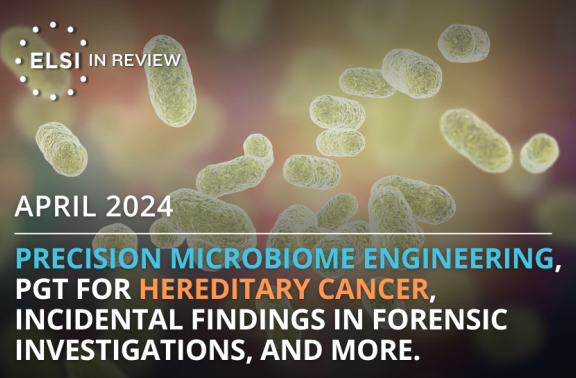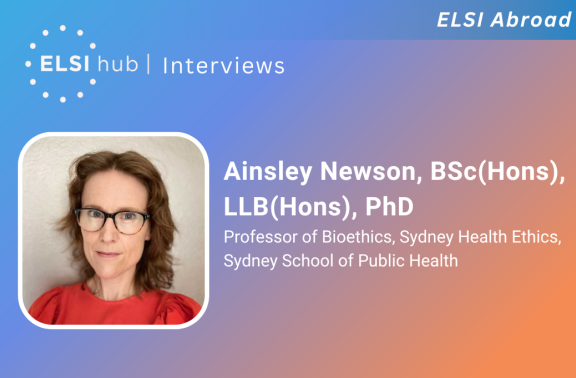
Should I Submit This Paper to the American Journal of Bioethics? CERA Interviews AJOB Editor-in-Chief David Magnus
Editor-in-Chief and co-founder of the American Journal of Bioethics (AJOB), David Magnus, Ph.D., is well positioned to explain the advantages of selecting this journal as a home for your ELSI scholarship. When he co-founded the title with Glenn McGee 20 years ago, bioethics was articulating its response to a flurry of technological developments. The Human Genome Project was two years from completion, scientists had cloned Dolly the sheep and isolated pluripotent human embryonic stem cells, and Jesse Gelsinger had recently died in a clinical trial for gene therapy. A person who wears many hats, Dr. Magnus is Director of the Stanford Center for Biomedical Ethics; Thomas A. Raffin Professor of Medicine and Biomedical Ethics and Professor of Pediatrics at Stanford University; a member of the Stanford Hospital ethics committee; Vice-Chair of the Institutional Review Board for the National Institutes of Health (NIH) Precision Medicine Initiative, “All of Us”; and a member of the CERA Steering Committee. He has published extensively on topics in bioethics, including research ethics, genetics, stem cell research, organ transplantation, and patient communication.
CERA: How would you describe the relationship between the AJOB and the ELSI scholarly community?
Dr. Magnus: Bioethics and ELSI do not name “natural kinds.” Both are very loose, constructed, and contested categories. For the most part, I see most of ELSI as a subset of bioethics. Because I see the landscape this way, we publish material that is directly relevant to ELSI concerns. Our articles on ELSI and ELSI-adjacent topics are often among our most cited publications.
The last issue of AJOB had a target article and commentaries on the topic of privacy risks in multi-omic research. Other recent issues included articles on extending research protections to tribal communities, informed consent, results disclosure, and ethical issues in precision medicine. Sandra Lee’s article on reciprocity and responsibility in precision medicine, Michelle Bayefsky and Ben Berkman on expanded prenatal testing, and Nanibaa’ Garrison and colleagues on the rhetoric of genetic exceptionalism also come to mind. AJOB also publishes articles that are more ELSI adjacent (e.g., consent in research) and some that are not as interesting to the ELSI community, such as those on topics like brain death or clinical ethics.
AJOB occasionally publishes empirical articles (mostly qualitative studies). However, most of our articles are normative or conceptual pieces (even if they are derived from data). We have a daughter journal, AJOB Empirical Bioethics, that publishes empirical research exclusively. When we get a good manuscript that we don’t think is a good fit for AJOB, we offer to have it reviewed by AJOB Empirical. Over the years, most of the top folks in ELSI have published in AJOB (in addition to former NIH Director, Francis Collins), though researchers who exclusively do empirical ELSI research are more likely to publish in AJOB Empirical.
CERA: You co-founded AJOB. What can you tell us about the history of the journal?
Dr. Magnus: I was the founding co-Editor of the journal and Glenn McGee was the Editor-in-Chief. We were colleagues at Penn at the time. We started as a quarterly journal on a shoestring budget. Some of the key aspects of the journal, particularly the target article and open peer commentary format, in which target articles are published alongside responses from the scholarly community, were part of the journal from the start. That format was frankly copied from Behavioral and Brain Sciences (where I published my first two publications). I was convinced that dialogue and debate among scholars from different disciplines would work for our field. Glenn added the idea that internet resources and new developments in social media were important for a journal. As a result, AJOB was one the first journals in any field to have a blog.
The journal is committed to idea of dialectic—debate and conversation across disciplines and perspectives. That has also been part of the journal from the beginning. We have also been committed to dealing with cutting edge issues. I would say we are increasingly focused on issues of justice and equity (though that has long been at least present in the journal).
CERA: What kinds of ELSI papers are you especially excited about right now?
Dr. Magnus: Papers that discuss issues related to diversity, equity, and inclusion are very important right now. I’m also very interested in new technologies that may have a significant impact on research (or at least a lot of hype), such as digital twin studies.
CERA: What journal plans for the coming year would you like to share with the ELSI community?
Dr. Magnus: We have overhauled our social media and our blog site and are launching the revision as Bioethics Today. We have also been exploring and experimenting with different ways of conveying information, for example, through webinars. We have an exciting one taking place Feb. 9 on Roe v. Wade in anticipation of the Supreme Court’s coming actions. There are a few other developments that will probably have to remain under wraps for now, but readers can check our website for updates.
CERA: The CERA offers the ELSI Journal Information Resource, a listing of the 40 most frequently occurring journal titles in the publications database of the NIH ELSI Research Program with details about the ELSI-relevant journal sections, manuscript types, and submission information. AJOB came in third on our list. What are some of the journal-specific advantages that you would highlight for ELSI scholars who are thinking about submitting their work to AJOB?
Dr. Magnus: Different journals have different niches. Most empirical pieces in ELSI would be a better fit for AJOB Empirical Bioethics. For others, AJOB gives authors 5,000-7,000 words (and sometimes longer) to really develop ideas and arguments. The target articles have been appropriate for generating significant discussion through their open peer commentaries. There is no better way to get a LOT of attention. Having a dozen commentary articles on your work is a great starting point toward the article having a major impact. All AJOB authors are invited to sign up to receive invitations to propose open peer commentaries. Anyone is welcome to write for our blog or submit an editorial.
CERA: What advice do you have for early career ELSI scholars?
Dr. Magnus: I am very supportive of the turn towards the empirical in our field, but there is value in stepping back and doing some serious normative and conceptual work to accompany or build on empirical ELSI research. I would advise scholars to learn how to publish a range of types of articles.
The ELSI Journal Information Resource is just one of the 1,000 resources available in the Additional Resources section of ELSIhub. Additional Resources is a collection of ELSI-relevant information curated by the CERA, including historical resources, policy resources, news outlets and blogs, data archives, and more. Please email us at [email protected] to suggest or share new Additional Resources with the ELSI community.



